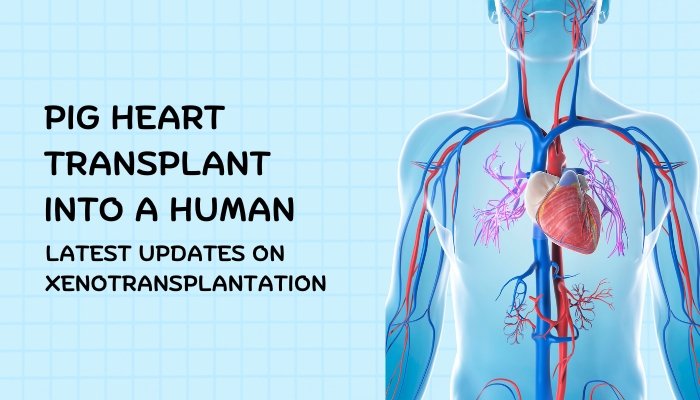Every one of us has seen an oxygen mask, either in real life scenarios or in movies. Some of us would have used it when being given oxygen in an emergency room or during surgery. We know it is used to deliver oxygen to maintain our breathing.
Oxygen needs to be given according to the situation, sometimes as a medical support or treatment, in high flying aircrafts, divers, fire fighters, space walkers and so on. But, the types of breathing masks are different according to the purpose it is used for.
The purpose of this article is to address the medical oxygen masks, their uses and their differences. Next time you see one, it would be easier to identify the specifics of the mask you are seeing.
Medical oxygen masks are used for supplying oxygen to the patient’s respiratory system when the normal oxygen present in the atmosphere is not sufficient or when more oxygen needs to be delivered. It is also used during surgery to supply oxygen along with anaesthetic gases to the lungs.
The normal air we breathe contains approximately 21% oxygen in it. Rest is Nitrogen (78%), argon, carbon dioxide and other gases [1]. The masks used in hospitals are generally disposable owing to prevent cross infections.
It should be remembered that oxygen at higher concentrations can be harmful to the body. Maintaining the required flow of oxygen by monitoring the patient is actually very important. For this purpose, the oxygen masks used in hospitals are of 3 types- Simple, non-rebreather and partial rebreather masks.
Simple mask
Components
- Face mask – The face mask covers both nose and mouth. There are no valves to limit the flow of air. The exhaled air passes through the exhalation ports on the mask.
- Elastic cord- This helps in fixing the mask over the patient’s face to cover the nose and mouth.
- Oxygen supply tube- Connects the main oxygen supply to mask.
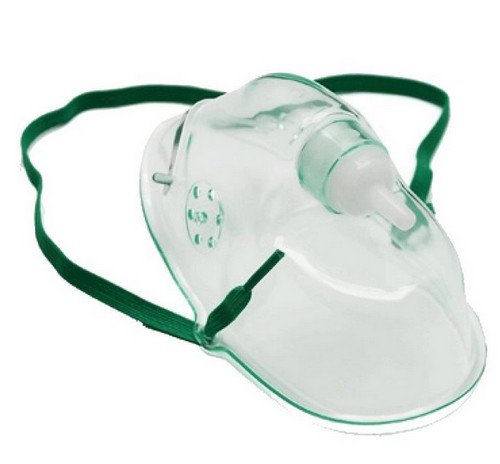
Photo 1: Image of a simple oxygen mask.
Image Source: cdns.webareacontrol.com

Picture 2: Image showing the components of a simple oxygen mask and how it is worn.
Image Source: allthingsphysicianassistant.files.wordpress.com
Purpose
The purpose of such a mask is to deliver low flow of oxygen continuously. A simple mask can deliver oxygen at a concentration of about 28-50% [10] at a flow rate of 5- 10 LPM (Litres per minute).
Indication
- Mild to moderate respiratory distress[12]
Non-rebreather mask (Hudson mask)
Components
- Face mask with 2 one-way valves- The face mask covers both nose and mouth. A one-way valve is present between the reservoir bag and the face mask. Oxygen can only flow from the reservoir bag to the mask. The valve prevents entry of exhaled air into the bag. Another one-way valve is present on the mask which lets the exhaled air to flow out to the atmosphere but prevents atmospheric air entering in. Hence, there is no re-breathing [2, 5].
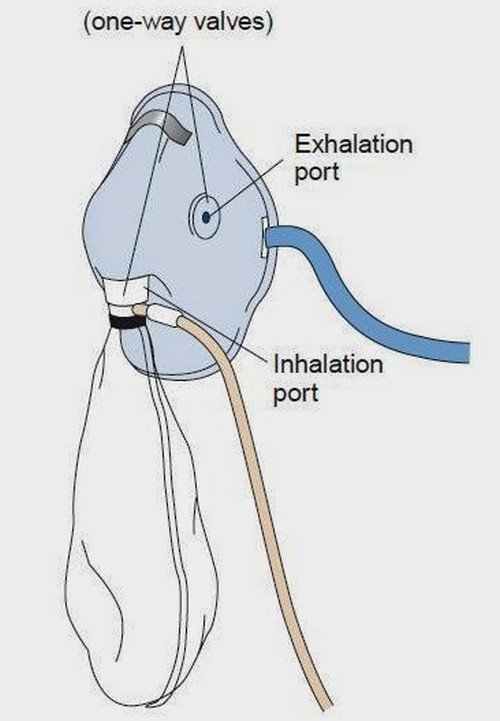
Picture 3: Image of a non-rebreather mask with its components
Photo Source: 2.bp.blogspot.com
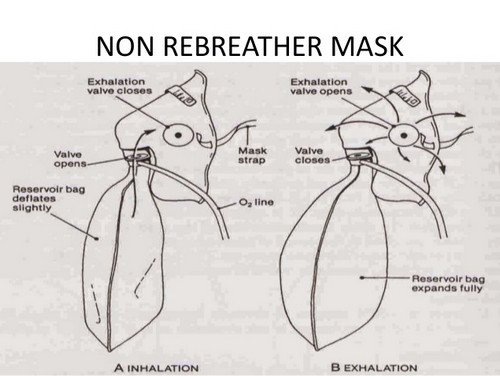
Photo 4: A picture depicting how the valves work in a non-rebreather mask.
Image Source: image.slidesharecdn.com
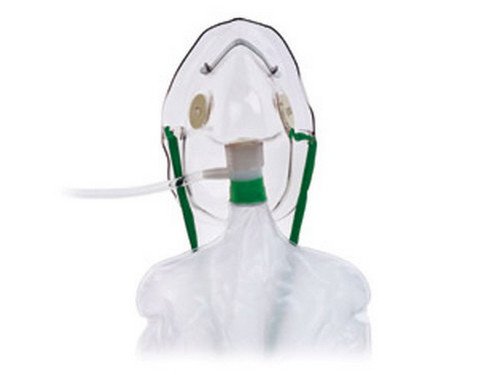 Photo 5: Non-rebreather mask
Photo 5: Non-rebreather mask
Image Source: static1.squarespace.com
- Elastic cord- This helps in fixing the mask over the patient’s face to cover the nose and mouth with a sufficient sealing so that atmospheric air does not get mixed with the oxygen in the mask.
- Reservoir bag- The bag is connected to the main supply of oxygen, an oxygen tank or a central oxygen supply, by an oxygen supply tube. The oxygen received from the tank is collected in the bag and delivered to the patient as he/she inhales, through a one-way valve. Usually the bag is around 1 litre in capacity. With each breath being inhaled, around 1/3rd of the bag gets deflated, and is replaced from the main oxygen supply. Remember that if the bag gets fully deflated, the patient will not have any source of oxygen for inhalation.
- Oxygen supply tube- Connects the main oxygen supply to the reservoir bag.
Purpose
The purpose of such a mask is to deliver high concentration of oxygen without it getting diluted by exhaled air or the atmospheric air which has lower concentrations of oxygen. A non-rebreather mask can deliver oxygen close to concentration of 80-100%. Generally an expected concentration of 60-80% is surely delivered to the patient [3, 4, 5].
Indication
A non-rebreather mask is only used in patients who can breathe unassisted. The recommended flow rate of oxygen with a non-rebreather mask is around 12- 15 LPM (Litres per minute) [2]. Those who require assistance in breathing should be given mechanical ventilation [5].
- Physical trauma
- Cluster headache
- Carbon monoxide poisoning
- Smoke inhalation
- Chronic airway obstruction
Partial rebreather mask
Components
Face mask with 1 two-way valve- This is similar to a non-rebreather mask. The difference is in the valve that connects between the reservoir bag and the face mask. Here, the valve is a two-way valve. This allows the first 1/3rd of breathe that is exhaled to get into the reservoir bag.
Remaining exhaled air flows out to the atmosphere through the exhalation ports on the mask. The first part of exhaled air is inhaled again from the reservoir bag. The first 1/3rd of exhaled air is the air held in the dead space (space where there is no exchange of air in the lungs), that is the trachea. Since it is the air from the dead space, it contains unused oxygen[6, 7, 8].
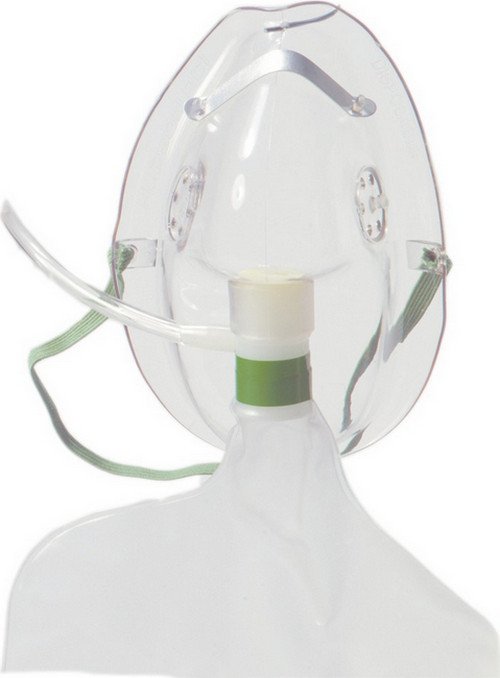
Picture 6: Partial rebreather mask.
Image Source: cdn.drivemedical.com
- Elastic cord- This helps in fixing the mask over the patient’s face to cover the nose and mouth with a sufficient sealing.
- Reservoir bag- The bag is connected to the main supply of oxygen, an oxygen tank or a central oxygen supply, by an oxygen supply tube. The oxygen received from the tank along with the first 1/3rd of exhaled air is collected in the bag and delivered to the patient as he/she inhales, through a two-way valve. Usually the bag is around 1 litre in capacity. With each breath being inhaled, around 1/3rd of the bag gets deflated, and is replaced from the main oxygen supply.
- Oxygen supply tube- Connects the main oxygen supply to the reservoir bag.
Purpose
This bag is also used to deliver higher concentrations of oxygen which is more than that could be received through a simple mask. Further, this also reduces the oxygen consumption as the unused oxygen within the dead space can be reused. The partial rebreather can deliver oxygen up to a concentration of 40-70% at a flow rate of 5-15 LPM (litres per minute) [9, 10].
Indication
- Hypoxia
- Respiratory disease
- Cardiac disease
- Shock
- Trauma
- Severe blood loss
- Seizures[11]
Difference between – Non-rebreather mask, Partial rebreather mask and Simple mask
| Advantage | Disadvantage | Flow rate | O2 Concentration achieved | |
| Simple mask |
|
|
|
|
| Non-rebreather mask |
|
|
|
|
| Partial rebreather mask |
|
|
|
|
Table 1: Table showing the basic advantages, disadvantages, flow rates and achieved oxygen concentrations with the different masks.
Reference:
- https://en.wikipedia.org/wiki/Atmosphere_of_Earth
- https://www.nursingtimes.net/clinical-archive/respiratory/respiratory-procedures-use-of-a-non-rebreathing-oxygen-mask/200184.article
- Garcia JA, Gardner D, Vines D, Shelledy D, Wettstein R, Peters J (October 2005). Chest Meeting 128 (4): 389S–390S.
- Earl, John. “Delivery of High FiO2”
- https://en.wikipedia.org/wiki/Non-rebreather_mask
- http://dev.studyguide.pls.pearsoncmg.com/pls/products/coco/emt_ap/1256897140/presentations/vea_emt_03_04_07.html
- https://medical-dictionary.thefreedictionary.com/partial+rebreathing+mask
- https://www.slideshare.net/cetdmgh/oxygen-therapy-30442604
- https://www.slideshare.net/AdilFarooq10/oxygen-delivery-devices-dr-adil-farooq
- https://en.wikipedia.org/wiki/Oxygen_therapy
- https://healthfully.com/rebreather-vs-nonrebreather-mask-6084936.html
- https://www.slideshare.net/sunilagrawal9693/techniques-of-oxygen-delivery

